Sun’s T2000 “Coolthreads” Server: First Impressions and Experiences
by Johan De Gelas on March 24, 2006 12:05 AM EST- Posted in
- IT Computing
Introducing the T2000 server
The Sun fire T2000 is more than just a server with the out-of-the-ordinary UltraSPARC T1 CPU. 16 DIMM slots support up to 32Gbytes of DDR2-533 memory. Internally, there is room for 4 SAS 73GB, 2.5" disks. Don't confuse these server grade disks with your average notebook 2.5" disks. These are fast 10.000 RPM Serial Attached SCSI (SAS) hard disk drives. With SAS, you can also use SATA disks, but you will be probably limited to 7200 RPM disks.
The T2000 in practice
The T2000 is a headless server. To get it up and running, you first access the serial management port with Hyperterminal or a similar tool. The necessary RJ-45 serial cable was included with our server.
The console software offers you plenty of different commands to administer the T2000 server.
RAS
Traditionally, Sun systems have been known for excellent RAS capabilities. Besides the obligatory redundant hot swappable fans, the T2000 also incorporates dual redundant hot swap Power.
Sun also claims that the T1 CPU excels in RAS. See below for a comparison between the RAS capabilities of the current Xeon and UltraSparc T1 (source: Sun).
In fact, current Intel production Xeon Paxville processor - which find a place in similarly priced servers as the T2000 - do not support Parity checking on the L1 I-Cache - Tag. Intel also pointed out that the upcoming Woodcrest CPU will have improved RAS features.
So, it seems that right now, the Ultrasparc T1 outshines its x86 competitors.
The T2000 also features Chipkill(memory), which complements standard ECC. According to Sun, this provides twice the level of reliability of standard ECC. Chipkill detects failed DRAM, then DRAM Sparing reconfigures a DRAM channel to map out failed DIMM.
Each of UltraSPARC T1's 4x memory controllers implements background error scanner/scrubber to reduce multi-nibble errors - programmable to adjust frequency of error scanning.
When it comes to RAS, especially the cheaper T2000 (with 1 GHz CPU), there is not an equal at their price point in the server market.
The Sun fire T2000 is more than just a server with the out-of-the-ordinary UltraSPARC T1 CPU. 16 DIMM slots support up to 32Gbytes of DDR2-533 memory. Internally, there is room for 4 SAS 73GB, 2.5" disks. Don't confuse these server grade disks with your average notebook 2.5" disks. These are fast 10.000 RPM Serial Attached SCSI (SAS) hard disk drives. With SAS, you can also use SATA disks, but you will be probably limited to 7200 RPM disks.
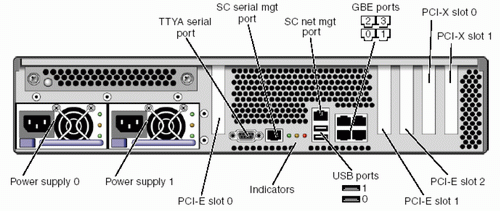
The T2000 in practice
The T2000 is a headless server. To get it up and running, you first access the serial management port with Hyperterminal or a similar tool. The necessary RJ-45 serial cable was included with our server.
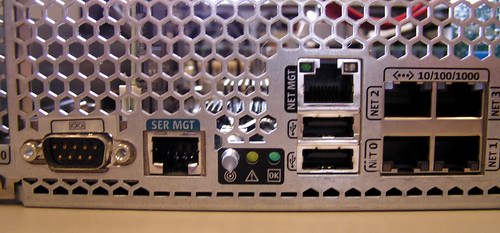
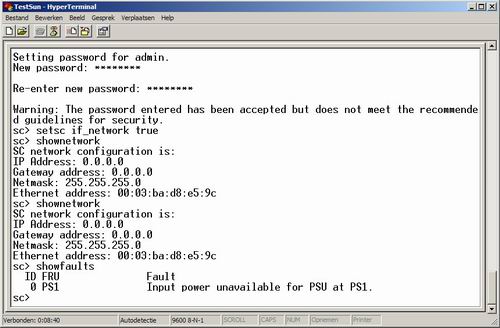
The console software offers you plenty of different commands to administer the T2000 server.
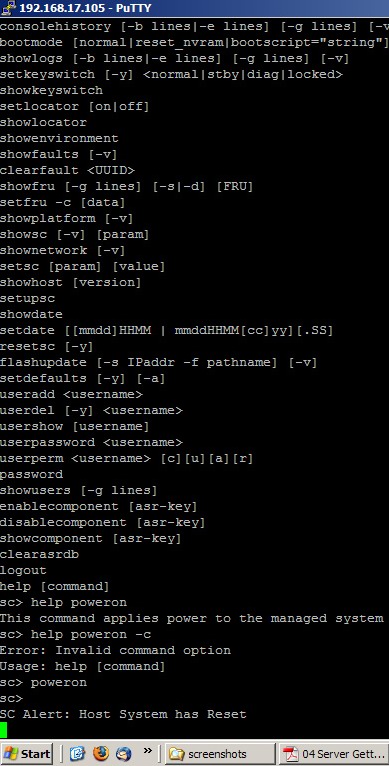
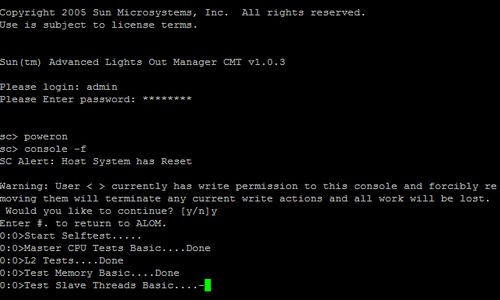
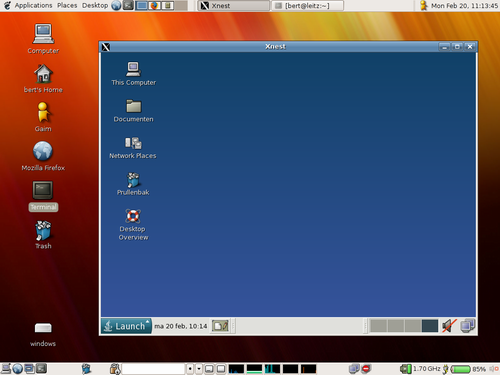
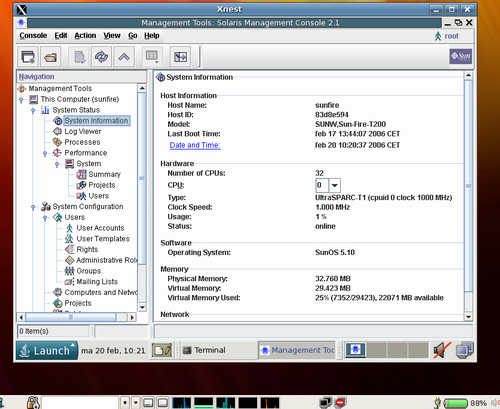
RAS
Traditionally, Sun systems have been known for excellent RAS capabilities. Besides the obligatory redundant hot swappable fans, the T2000 also incorporates dual redundant hot swap Power.
Sun also claims that the T1 CPU excels in RAS. See below for a comparison between the RAS capabilities of the current Xeon and UltraSparc T1 (source: Sun).
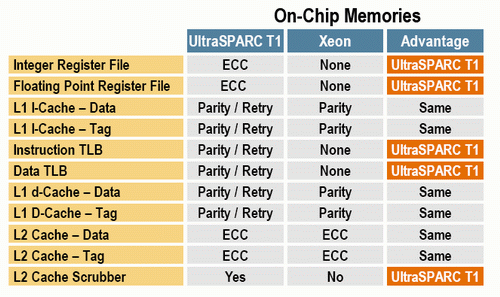
In fact, current Intel production Xeon Paxville processor - which find a place in similarly priced servers as the T2000 - do not support Parity checking on the L1 I-Cache - Tag. Intel also pointed out that the upcoming Woodcrest CPU will have improved RAS features.
So, it seems that right now, the Ultrasparc T1 outshines its x86 competitors.
The T2000 also features Chipkill(memory), which complements standard ECC. According to Sun, this provides twice the level of reliability of standard ECC. Chipkill detects failed DRAM, then DRAM Sparing reconfigures a DRAM channel to map out failed DIMM.
Each of UltraSPARC T1's 4x memory controllers implements background error scanner/scrubber to reduce multi-nibble errors - programmable to adjust frequency of error scanning.
When it comes to RAS, especially the cheaper T2000 (with 1 GHz CPU), there is not an equal at their price point in the server market.










26 Comments
View All Comments
JackPack - Friday, March 24, 2006 - link
Pleasant to read as usual, Johan.BTW, are they letting you keep the T2000?
http://blogs.sun.com/roller/page/jonathan?entry=ni...">http://blogs.sun.com/roller/page/jonathan?entry=ni...
PandaBear - Friday, March 24, 2006 - link
In terms of Branded server it is a good price, but as benchmark have shown, a Dual Opteron running Linux both perform better and use less power. I think people who buy these class of server want support and service (and build quality) and in that case Sun certain would win the whitebox builder no matter how good a Dual Opteron is.Nonetheless it is a good product, for the one who demand this kind of quality. Now Intel's solution really looks bad.
Calin - Friday, March 24, 2006 - link
I don't know what you are talking about - if you would up the memory on the Opteron HE (2CPU of 2 cores) to 32GB, the power consumption would be almost the same (assuming 6W per 4GB of RAM, it would be at 234W. Close enough to be considered equal, I'd say.Also, wouldn't populating all the possible memory slots on the Opteron decrease a bit its performance? I don't know about Opteron, but Athlon64 decrease its command rate (Help, Johan! :) ) when working with all the memory channels filled.
I agree about the better performance of the Opteron server, but regarding the power use, it is the same as the Sun's recent offering. Maybe the introduction of the DDR2 Opterons would change the power envelope, but until then, the T1 might have some aces up its sleeve
JohanAnandtech - Friday, March 24, 2006 - link
You must calculate about 4-5 Watt per 2 GB Dimm. Based on the measurements I did and slightly guessing I think a 32 GB Opteron HE with 32 GB would definitely consume more than The T2000 as also have to count a few Watts per memory channel.Indeed, fully loaded DIMM channels will probably throttle back to lower speeds. I am not sure about Command rate though (BTW, it increases on the Athlon 64 not decreases :-), as it is possible less important with buffered DIMMs.
About performance, we still have to test a lot of scenario's (jsp, databases). The impression of the T2000 might still change.
Zoomer - Sunday, April 9, 2006 - link
2xx Opterons use rigistered ram, so its not an issue like with the 1xx 939s.Calin - Friday, March 24, 2006 - link
I just took the difference measured between the 2xOpteron HE with 4 and 8 GB or RAM (192 and 198W), shown in the table on the last page. I know that even rounding errors might change that between 4 and 8W, but anyway, Opterons won't use less power than the T1.Very interesting article, and I eagerly await for the sequels :D